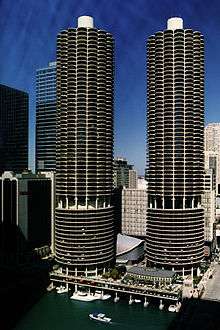Mixed-use development

Mixed-use development is a type of urban development that blends residential, commercial, cultural, institutional, or industrial uses, where those functions are physically and functionally integrated, and that provides pedestrian connections.[1][2] Mixed-use development can take the form of a single building, a city block, or entire neighbourhoods. The term may also be used more specifically to refer to a mixed-use real estate development project—a building, complex of buildings, or district of a town or city that is developed for mixed-use by a private developer, (quasi-) governmental agency, or a combination thereof.
Traditionally, human settlements have developed in mixed-use patterns. However, with industrialisation as well as the invention of the skyscraper, governmental zoning regulations were introduced to separate different functions, such as manufacturing, from residential areas. In the United States, the heyday of separate-use zoning was after World War II, but since the 1990s, mixed-use zoning has once again become desirable as the benefits are recognized. These benefits include:[3]
- greater housing variety and density
- reduced distances between housing, workplaces, retail businesses, and other destinations
- more compact development
- stronger neighborhood character
- pedestrian and bicycle-friendly environments
Benefits
Benefits of mixed-use development include:[3][4]
- greater housing variety and density, more affordable housing (smaller units), life-cycle housing (starter homes to larger homes to senior housing)
- reduced distances between housing, workplaces, retail businesses, and other amenities and destinations
- better access to fresh, healthy foods (as food retail and farmers markets can be accessed on foot/bike or by transit)
- more compact development, land-use synergy (e.g. residents provide customers for retail which provide amenities for residents)
- stronger neighborhood character, sense of place
- walkable, bike-able neighborhoods, increased accessibility via transit, both resulting in reduced transportation costs
Types of contemporary mixed-use zoning
Some of the more frequent mixed-use scenarios in the United States are:[2]
- Neighborhood commercial zoning – convenience goods and services, such as convenience stores, permitted in otherwise strictly residential areas
- Main Street residential/commercial – two to three-story buildings with residential units above and commercial units on the ground floor facing the street
- Urban residential/commercial – multi-story residential buildings with commercial and civic uses on ground floor
- Office convenience – office buildings with small retail and service uses oriented to the office workers
- Office/residential – multi-family residential units within office building(s)
- Shopping mall conversion – residential and/or office units added (adjacent) to an existing standalone shopping mall
- Retail district retrofit – retrofitting of a suburban retail area to a more village-like appearance and mix of uses
- Live/work – residents can operate small businesses on the ground floor of the building where they live
- Studio/light industrial – residents may operate studios or small workshops in the building where they live
- Hotel/residence – mix hotel space and high-end multi-family residential
- Parking structure with ground-floor retail
- Single-family detached home district with standalone shopping center
See also
- Activity centre
- Automobile dependency
- Edge city
- Main Street
- New Urbanism
- Principles of Intelligent Urbanism
- Public space
- Single-use zoning
- Smart growth
- Sustainable development
- Third Place
- Transit-oriented development
- Urban design
- Urban sprawl
Notes
- ↑ Business Geography and New Real Estate Market Analysis, Grant Ian Thrall, p.216
- 1 2 "Quality Growth Toolkit: Mixed-use Development", Atlanta Regional Commission. p.2
- 1 2 American Planning Association, "Planning and Community Health Research Center: Mixed Use Development
- ↑ "Mixed Use Zoning", Livable New York Resource Manual
Further reading
- Reclaiming the City, 1997, Andy Coupland
- "Mixed use development, practice and potential", Department for Communities and Local Government, UK Government
- What is functional mix?, Planning Theory and Practice 18(2):249-267 · February 2017
External links
 Media related to Multipurpose buildings at Wikimedia Commons
Media related to Multipurpose buildings at Wikimedia Commons